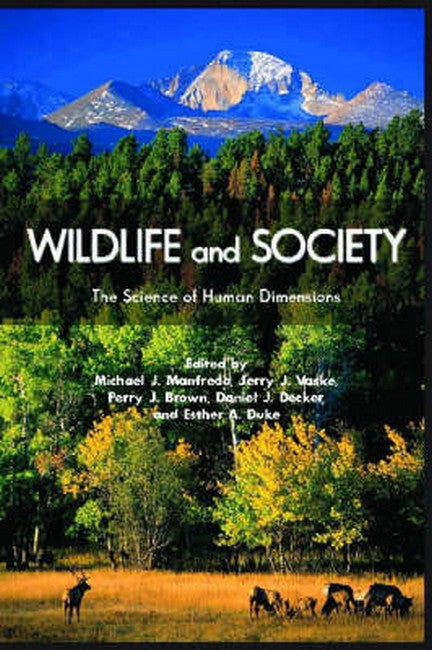Acknowledgments
Chapter 1. Introduction: Perspectives on the Past and Future of Human Dimensions of Fish and Wildlife
-Lessons from Our History
-What Might the Future Hold?
-Exploring the Human Dimensions of Fish and Wildlife
-Literature Cited
PART I. Social Factors Creating Change in Fish and Wildlife Conservation
Chapter 2. Social and Demographic Trends Affecting Fish and Wildlife Management
Chapter 3. Understanding Global Values toward Wildlife
Chapter 4. The Emergence of Conservation NGOs as Catalysts for Local Democracy
Chapter 5. Imagining the Future: Humans, Wildlife, and Global Climate Change
PART II. Building the Social Component into the Philosophy of Wildlife Management
Chapter 6. The Changing Culture of Wildlife Management
Chapter 7. Toward a Framework for Integrating Human Dimensions in Wildlife Management
Chapter 8. Comanaging Wildlife in the Amazon and the Salvation of the Pacaya-Samiria National Reserve in Peru
Chapter 9. Working with Communities to Achieve Conservation Goals
Chapter 10. Humans and Wildlife as Ecosystem Components in Integrated Assessments
PART III. Dealing with Legal and Institutional Factors of Fish and Wildlife Management
Chapter 11. Legal Trends in Fish And Wildlife Policy
Chapter 12. Reviving the Public Trust Doctrine as a Foundation for Wildlife Management in North America
Chapter 13. A ''Wicked''? Problem: Institutional Structures and Wildlife Management Success
Chapter 14. Fueling the Conservation Engine: Where Will the Money Come From to Drive Fish and Wildlife Management and Conservation?
PART IV. Social Perspectives on Contemporary Fish and Wildlife Management Issues
Chapter 15. The Socioecology of Urban Wildlife Management
Chapter 16. The Human Dimensions of Conflicts with Wildlife around Protected Areas
Chapter 17. New Markets for Recreational Fishing
Chapter 18. Preparing for the Next Disease: The Human-Wildlife Connection
Chapter 19. Challenges and Opportunities at the Interface of Wildlife-Viewing Marketing and Management in the Twenty-First Century
Chapter 20. Trends in Access and Wildlife Privatization
Chapter 21. Social Dimensions of Managing Hunting in Tropical Forests
Chapter 22. Communication as an Effective Management Strategy in a Diverse World
Chapter 23. Conclusion: What Is Wildlife Management?
About the Contributors
Index
Chapter 1. Introduction: Perspectives on the Past and Future of Human Dimensions of Fish and Wildlife
-Lessons from Our History
-What Might the Future Hold?
-Exploring the Human Dimensions of Fish and Wildlife
-Literature Cited
PART I. Social Factors Creating Change in Fish and Wildlife Conservation
Chapter 2. Social and Demographic Trends Affecting Fish and Wildlife Management
Chapter 3. Understanding Global Values toward Wildlife
Chapter 4. The Emergence of Conservation NGOs as Catalysts for Local Democracy
Chapter 5. Imagining the Future: Humans, Wildlife, and Global Climate Change
PART II. Building the Social Component into the Philosophy of Wildlife Management
Chapter 6. The Changing Culture of Wildlife Management
Chapter 7. Toward a Framework for Integrating Human Dimensions in Wildlife Management
Chapter 8. Comanaging Wildlife in the Amazon and the Salvation of the Pacaya-Samiria National Reserve in Peru
Chapter 9. Working with Communities to Achieve Conservation Goals
Chapter 10. Humans and Wildlife as Ecosystem Components in Integrated Assessments
PART III. Dealing with Legal and Institutional Factors of Fish and Wildlife Management
Chapter 11. Legal Trends in Fish And Wildlife Policy
Chapter 12. Reviving the Public Trust Doctrine as a Foundation for Wildlife Management in North America
Chapter 13. A ''Wicked''? Problem: Institutional Structures and Wildlife Management Success
Chapter 14. Fueling the Conservation Engine: Where Will the Money Come From to Drive Fish and Wildlife Management and Conservation?
PART IV. Social Perspectives on Contemporary Fish and Wildlife Management Issues
Chapter 15. The Socioecology of Urban Wildlife Management
Chapter 16. The Human Dimensions of Conflicts with Wildlife around Protected Areas
Chapter 17. New Markets for Recreational Fishing
Chapter 18. Preparing for the Next Disease: The Human-Wildlife Connection
Chapter 19. Challenges and Opportunities at the Interface of Wildlife-Viewing Marketing and Management in the Twenty-First Century
Chapter 20. Trends in Access and Wildlife Privatization
Chapter 21. Social Dimensions of Managing Hunting in Tropical Forests
Chapter 22. Communication as an Effective Management Strategy in a Diverse World
Chapter 23. Conclusion: What Is Wildlife Management?
About the Contributors
Index

